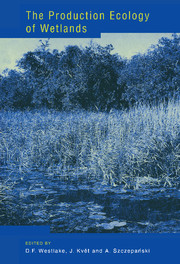Book contents
- Frontmatter
- Contents
- List of contributors
- Preface
- Foreword
- 1 General ecology of wetlands
- 2 Primary production in wetlands
- 3 Further fate of organic matter in wetlands
- 4 The role of decomposers in wetlands
- 5 The role of animals and animal communities in wetlands
- 6 Mineral economy and cycling of minerals in wetlands
- 7 Micro-climatic conditions and water economy of wetlands vegetation
- 8 The management of wetlands
- References
- Index
5 - The role of animals and animal communities in wetlands
Published online by Cambridge University Press: 27 October 2009
- Frontmatter
- Contents
- List of contributors
- Preface
- Foreword
- 1 General ecology of wetlands
- 2 Primary production in wetlands
- 3 Further fate of organic matter in wetlands
- 4 The role of decomposers in wetlands
- 5 The role of animals and animal communities in wetlands
- 6 Mineral economy and cycling of minerals in wetlands
- 7 Micro-climatic conditions and water economy of wetlands vegetation
- 8 The management of wetlands
- References
- Index
Summary
Introduction
This chapter is primarily a summary of results of studies on selected animal groups and communities inhabiting various types of wetlands in Europe, Asia, Africa and America. Many of the data were obtained during the International Biological Programme.
The rules governing the formation and development of wetland animal communities and their productivity are still insufficiently understood. First of all, a synthetic approach to their study is largely lacking for several reasons, mainly the recent recognition of many of the problems involved. Wetlands have been studied intensely only during the last 40 years or so and a relatively small number of zoologists specialise in the study of wetland animal communities and their productivity. Another reason is the great ecological variety of wetland ecosystems (see Chapter 1), leading to generally fragmentary and inconsistent knowledge about them and about their animal components in particular.
For these reasons, the present chapter has been conceived more as a review rather than as a true synthesis. The authors have also confined their attention to the most-studied and best-known animal groups and communities living in wetlands, without attempting to provide a complete and exhaustive picture of all animal life and its role in these ecosystems.
Some manuscripts, data, reviews and correspondence used in writing the chapters are deposited in the library of the Institute of Botany at Třeboň, Czech Republic, where they may be consulted.
- Type
- Chapter
- Information
- The Production Ecology of WetlandsThe IBP Synthesis, pp. 211 - 318Publisher: Cambridge University PressPrint publication year: 1999
- 3
- Cited by



